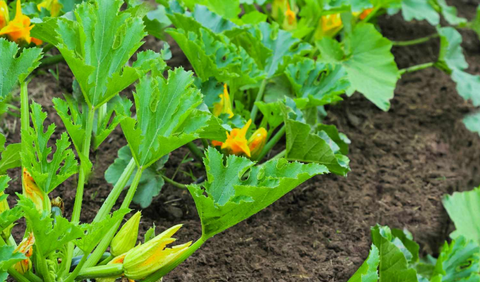Companion planting is a savvy gardening strategy that enhances the beauty and health of your garden by growing plants together that benefit each other. When it comes to lilies, their tall, elegant blooms can be complemented perfectly by a variety of plants. Whether you’re looking to boost aesthetics, improve soil, or manage pests naturally, choosing the right companions for your lilies can transform your garden into a lush, thriving ecosystem.

Choosing the Right Companions for Lilies
Factors to Consider: Sunlight, Soil, and Water Needs
Lilies typically prefer full sun and well-drained soil. When selecting companion plants, ensure they have similar sunlight, soil, and water requirements to avoid any mismatches that could stress your plants.
Matching Growth Habits and Heights
Consider the growth habits and mature heights of companion plants. Pairing lilies with plants that complement their stature ensures that no one plant overshadows the others, maintaining a balanced garden structure.
Complementary Bloom Times and Colors
For a continuous display of color, choose companions that bloom at different times than your lilies. This staggered approach keeps your garden vibrant throughout the growing season.
Perennial Companions for Lilies
Daylilies: Double the Beauty
Daylilies are excellent partners for true lilies, offering similar growing conditions and adding a burst of color when lilies are not in bloom. Their robust and hardy nature makes them easy to care for, doubling the beauty in your garden.
Hostas: Lush Foliage for Contrast
Hostas provide lush, dense foliage that contrasts beautifully with the upright, elegant stalks of lilies. Their wide, shade-loving leaves help suppress weeds and keep the soil cool and moist.
Astilbes: Feathery Blooms and Texture
Astilbes bring delicate, feathery blooms that add texture and a soft touch to your lily beds. Their preference for part shade and moist soil makes them a perfect underplanting for taller lilies.
Annuals That Pair Well with Lilies
Marigolds: Bright and Beneficial
Marigolds are not only vibrant and cheerful but also beneficial for pest control. Their scent deters many common garden pests, protecting your lilies while adding a pop of bright color.
Zinnias: Bold, Long-Lasting Blooms
Zinnias offers long-lasting, bold blooms in a variety of colors. They thrive in full sun and can fill in gaps between lily plants, ensuring your garden remains lively and colorful throughout the season.
Petunias: Easy and Colorful Fillers
Petunias are versatile and easy to grow, making them excellent fillers for any gaps in your lily beds. Their wide range of colors and long blooming period make them a garden favorite.

Bulb Companions for Lilies
Daffodils: Early Bloomers for Season-Long Interest
Daffodils bloom early in the spring, providing color and interest before lilies take the stage. Their bulbs also deter rodents, protecting lily bulbs from being eaten.
Tulips: Classic Spring Beauty
Tulips offer classic beauty with their vibrant spring blooms. Planting them alongside lilies ensures a seamless transition of color from early to late spring.
Alliums: Unique Shapes and Pest Repellent Qualities
Alliums, with their unique globe-shaped blooms, add architectural interest to your garden. Their natural pest-repellent qualities also help protect your lilies from unwanted visitors.
Shrubs to Grow with Lilies
Hydrangeas: Big Blooms and Structure
Hydrangeas provide structure and large, showy blooms that complement the tall elegance of lilies. Their preference for moist, well-drained soil makes them ideal partners.
Roses: Timeless Elegance
Roses and lilies together create a garden of timeless elegance. Both prefer sunny spots and well-drained soil, and their combined blooms can create a stunning, romantic display.
Spireas: Compact and Colorful
Spireas are compact shrubs that add color and texture with their clusters of small blooms. Their manageable size and easy care make them perfect for filling in spaces around lilies.
Ground Covers for Lily Beds
Creeping Thyme: Aromatic and Attractive
Creeping thyme forms a fragrant carpet of tiny flowers and foliage, making it an excellent ground cover for lily beds. Its low-growing habit prevents weed growth while adding a delightful aroma.
Sweet Woodruff: Shade-tolerant and Delicate
Sweet woodruff thrives in shaded areas, making it ideal for planting under taller lilies. Its delicate white flowers and sweet scent add charm to the garden.
Sedum: Succulent and Hardy
Sedums are hardy succulents that provide excellent ground cover. Their fleshy leaves and star-shaped flowers offer a unique texture and are drought-tolerant, making them low-maintenance companions.

Grasses and Sedges for Texture
Fountain Grass: Graceful Movement
Fountain grass adds graceful movement to your garden with its arching, feathery plumes. Its airy texture contrasts beautifully with the solid structure of lily stalks.
Blue Fescue: Cool Tones and Compact Growth
Blue fescue's cool blue-gray foliage and compact growth habit make it a perfect border plant for lily beds. It provides color contrast and low-maintenance appeal.
Japanese Forest Grass: Elegant and Easy Care
Japanese forest grass offers elegant, cascading foliage that brings a touch of sophistication to your garden. Its shade tolerance and low care requirements make it an excellent companion for lilies.
Vines and Climbers for Vertical Interest
Clematis: Stunning Blooms and Versatility
Clematis vines produce stunning blooms that can climb trellises or spill over garden walls, adding vertical interest. Their wide variety of colors and forms complement lilies beautifully.
Sweet Peas: Fragrant and Delightful
Sweet peas offer fragrant, delicate blooms that can climb and intertwine with lilies, adding a whimsical touch to your garden. Their sweet scent attracts pollinators, enhancing garden biodiversity.
Honeysuckle: Color and Wildlife Attraction
Honeysuckle vines bring vibrant color and a delightful fragrance to your garden. Their flowers attract hummingbirds and butterflies, making your lily garden a lively, wildlife-friendly space.
Herbs as Lily Companions
Lavender: Fragrance and Pollinator Friendly
Lavender's fragrant blooms and silvery foliage make it a beautiful and beneficial companion for lilies. It attracts pollinators while deterring pests, enhancing both the beauty and health of your garden.
Sage: Strong Scent and Bold Foliage
Sage offers bold, textured foliage and a strong scent that repels many pests. Its purple blooms add a splash of color and attract beneficial insects.
Thyme: Low-Growing and Useful
Thyme is a low-growing herb that makes an excellent ground cover around lilies. Its tiny, aromatic leaves and delicate flowers add beauty and utility to the garden.

Native Plants for a Natural Look
Coneflowers: Hardy and Attractive
Coneflowers are native perennials that thrive in many conditions and add a natural, wildflower look to your garden. Their daisy-like blooms attract pollinators and add a splash of color.
Black-Eyed Susans: Bright and Cheerful
Black-eyed Susans bring bright, cheerful yellow blooms that complement lilies' colors. Their hardy nature and long blooming period make them excellent companions.
Bee Balm: Perfect for Pollinators
Bee balm offers vibrant, tubular flowers that attract bees, butterflies, and hummingbirds. Its bright blooms and aromatic foliage make it a valuable addition to any lily garden.
Edibles to Grow with Lilies
Strawberries: Ground Cover and Delicious
Strawberries make a delightful ground cover around lilies, offering the dual benefit of weed suppression and delicious fruit. Their low-growing habit and spreading nature complement lily beds well.
Kale: Decorative and Nutritious
Kale's bold, textured leaves add visual interest to your garden while providing nutritious greens for your kitchen. Its cool-season growth habit makes it an excellent companion for lilies.
Chives: Easy to Grow and Beneficial
Chives are easy to grow and their purple pom-pom blooms add color and attract beneficial insects. Their onion-like scent can help deter pests, protecting your lilies.
Plants to Repel Pests
Garlic: Natural Pest Deterrent
Garlic is known for its strong scent, which repels many garden pests. Planting garlic around your lilies can help protect them from aphids, beetles, and other unwanted visitors.
Catnip: Keeps Aphids at Bay
Catnip's aromatic leaves repel aphids and other pests. Its attractive flowers and foliage make it a beneficial and ornamental addition to your garden.
Nasturtiums: Trap Crops for Pests
Nasturtiums act as trap crops, drawing pests away from your lilies. Their bright blooms add color to the garden while providing a natural pest control solution.

Creating a Pollinator-Friendly Garden
Butterfly Bush: Attracts Butterflies and Hummingbirds
Butterfly bush is a magnet for butterflies and hummingbirds with its nectar-rich blooms. Placing it near lilies not only enhances the beauty of your garden but also supports pollinators essential for plant reproduction.
Milkweed: Essential for Monarchs
Milkweed is crucial for monarch butterflies as it serves as their sole larval food source. Planting milkweed alongside lilies helps sustain these iconic butterflies through their life cycle, contributing to biodiversity.
Salvias: Nectar-Rich Blooms
Salvias produce nectar-rich flowers that attract a variety of pollinators, including bees and hummingbirds. Their long blooming period ensures a continuous food source, benefiting both lilies and surrounding plants.
Designing with Foliage Contrast
Dark vs. Light Foliage
Contrasting foliage colors, such as dark green hostas against light green or variegated lily leaves, create visual interest and depth in your garden beds. This juxtaposition highlights the unique characteristics of each plant.
Variegated Leaves for Added Interest
Plants with variegated leaves, like variegated hostas or Japanese forest grass, add texture and intrigue. They break up the monotony of solid colors and enhance the overall aesthetic appeal of your garden.
Textural Differences: Smooth vs. Rough
Incorporate plants with varying textures, such as the smooth leaves of daylilies against the rough, textured foliage of sage or thyme. This tactile contrast not only adds visual interest but also stimulates sensory experiences in your garden.
Troubleshooting Common Problems
Identifying Nutrient Deficiencies
Recognize symptoms of nutrient deficiencies, such as yellowing leaves or stunted growth, and adjust fertilizer applications accordingly. Soil testing can help identify specific nutrient imbalances and guide corrective measures.
Dealing with Overcrowding
Monitor plant spacing and thin overcrowded areas as needed to reduce competition for resources and improve air circulation. Transplanting or dividing plants can alleviate overcrowding and promote healthier growth.
Managing Pests and Diseases
Implement integrated pest management strategies to control pests without relying on harmful chemicals. Beneficial insects, natural predators, and resistant plant varieties can help manage pest populations effectively.
Companion planting with lilies offers numerous benefits beyond aesthetic appeal, enhancing soil health, promoting natural pest control, and supporting pollinator populations. By choosing the right companions based on sunlight, soil, and water needs, and considering factors like bloom times and foliage contrast, you can create a harmonious garden that thrives year-round. Whether you prefer perennials, annuals, bulbs, shrubs, or herbs, the key lies in thoughtful planning, proper maintenance, and a commitment to sustainable gardening practices. Experiment with different plant combinations, personalize your garden design and enjoy the beauty and diversity that companion planting brings to your outdoor space.









